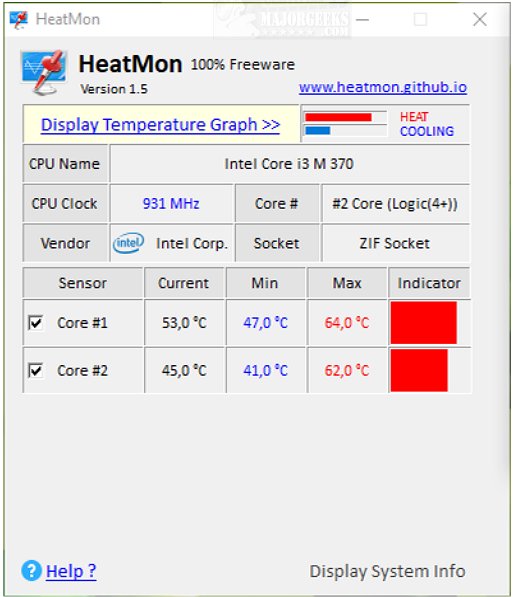HeatMon 1.5 has been released, introducing a powerful tool for monitoring CPU temperatures accurately. This software utilizes on-die sensors (DTS) to display the temperature of each CPU core, making it particularly effective for modern Intel and AMD processors that feature internal sensors. By focusing on the temperature readings near the CPU heat area, HeatMon ensures high accuracy in monitoring.
Key Features and Benefits
HeatMon serves several crucial functions in managing CPU performance:
1. Accurate Monitoring: The application provides real-time temperature and voltage data for each CPU core, allowing users to actively manage their system's performance. This is especially vital for laptops, where compact designs limit cooling efficiency.
2. Understanding CPU Behavior: CPUs often operate under a race-to-idle strategy, performing at peak levels for short intervals before scaling back to prevent overheating. HeatMon helps users keep track of these fluctuations to maintain optimal performance.
3. Simplified User Experience: Users can launch HeatMon without complex configurations, as it automatically begins tracking temperatures upon startup. This ease of use lowers the barrier for those unfamiliar with hardware monitoring.
4. Graphical Insights: The Ctrl+G hotkey activates a detailed graph that visually represents temperature and voltage readings. This feature allows users to quickly spot anomalies in system performance and temperature behavior.
5. Data Export Options: For users interested in record-keeping, HeatMon offers two methods for exporting data. Users can save graphical representations as high-quality PNG images or generate TXT reports capturing a snapshot of the data at a specific moment. The graph allows for continuous tracking, while the TXT report serves as a quick reference.
Conclusion
HeatMon is an essential utility for anyone aiming to deepen their understanding of system performance by closely monitoring CPU temperatures and voltages. Its combination of user-friendly features and precise data tracking makes it a valuable addition to any tech toolkit.
Future Enhancements
Looking ahead, potential enhancements for future versions of HeatMon could include:
- Integration with Other Hardware Monitoring Tools: Collaborating with other system monitoring software could provide a more comprehensive overview of system health, including GPU temperatures and system utilization metrics.
- Custom Alerts and Notifications: Implementing custom alerts for temperature thresholds could help users take immediate action before overheating occurs, further enhancing system stability and performance.
- Mobile Application: A companion mobile app could allow users to monitor their CPU temperatures remotely, providing convenience and real-time alerts on-the-go.
- User Community and Support: Creating a user community platform for sharing insights, tips, and troubleshooting could enhance user engagement and provide additional support for users experiencing issues.
With these potential improvements, HeatMon could solidify its position as a leading tool in CPU monitoring and performance optimization.
For more details, comprehensive documentation is available on the author's website
Key Features and Benefits
HeatMon serves several crucial functions in managing CPU performance:
1. Accurate Monitoring: The application provides real-time temperature and voltage data for each CPU core, allowing users to actively manage their system's performance. This is especially vital for laptops, where compact designs limit cooling efficiency.
2. Understanding CPU Behavior: CPUs often operate under a race-to-idle strategy, performing at peak levels for short intervals before scaling back to prevent overheating. HeatMon helps users keep track of these fluctuations to maintain optimal performance.
3. Simplified User Experience: Users can launch HeatMon without complex configurations, as it automatically begins tracking temperatures upon startup. This ease of use lowers the barrier for those unfamiliar with hardware monitoring.
4. Graphical Insights: The Ctrl+G hotkey activates a detailed graph that visually represents temperature and voltage readings. This feature allows users to quickly spot anomalies in system performance and temperature behavior.
5. Data Export Options: For users interested in record-keeping, HeatMon offers two methods for exporting data. Users can save graphical representations as high-quality PNG images or generate TXT reports capturing a snapshot of the data at a specific moment. The graph allows for continuous tracking, while the TXT report serves as a quick reference.
Conclusion
HeatMon is an essential utility for anyone aiming to deepen their understanding of system performance by closely monitoring CPU temperatures and voltages. Its combination of user-friendly features and precise data tracking makes it a valuable addition to any tech toolkit.
Future Enhancements
Looking ahead, potential enhancements for future versions of HeatMon could include:
- Integration with Other Hardware Monitoring Tools: Collaborating with other system monitoring software could provide a more comprehensive overview of system health, including GPU temperatures and system utilization metrics.
- Custom Alerts and Notifications: Implementing custom alerts for temperature thresholds could help users take immediate action before overheating occurs, further enhancing system stability and performance.
- Mobile Application: A companion mobile app could allow users to monitor their CPU temperatures remotely, providing convenience and real-time alerts on-the-go.
- User Community and Support: Creating a user community platform for sharing insights, tips, and troubleshooting could enhance user engagement and provide additional support for users experiencing issues.
With these potential improvements, HeatMon could solidify its position as a leading tool in CPU monitoring and performance optimization.
For more details, comprehensive documentation is available on the author's website
HeatMon 1.5 released
HeatMon provides accurate CPU temperature monitoring capable of displaying the temperature of each CPU core using on-die sensors (DTS) and can read socket sensors if supported. Most modern Intel and AMD processors have internal sensors, making this method the most accurate for monitoring core temperatures near the CPU heat area.


